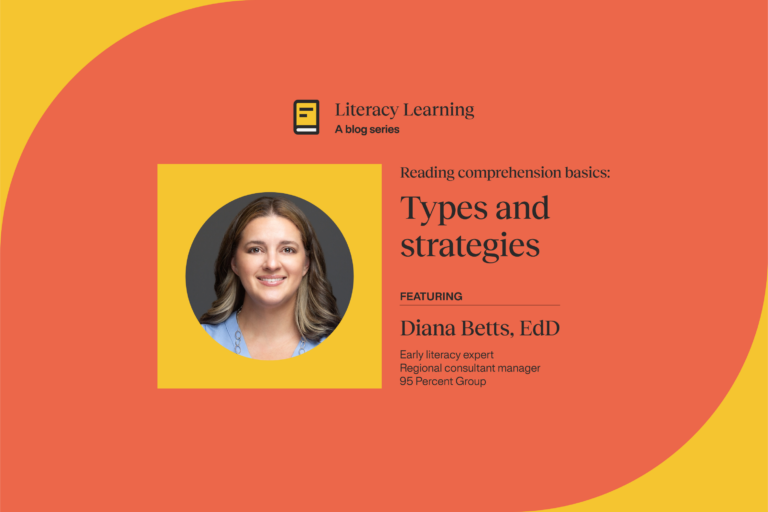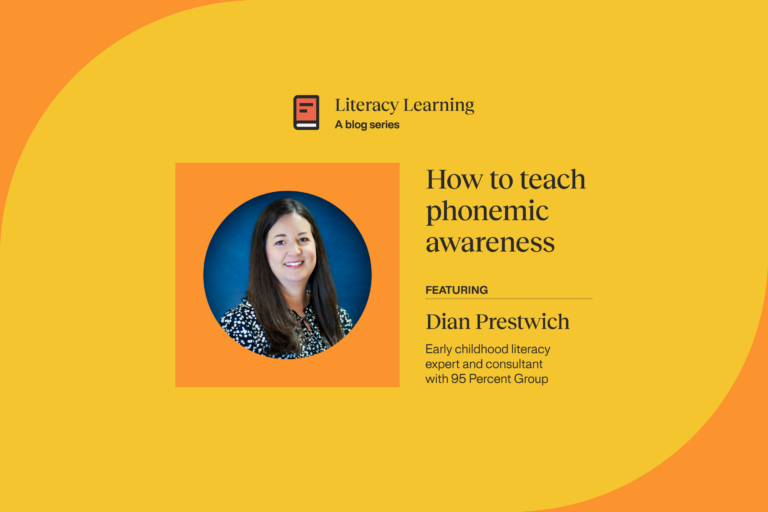Reading improvement based in evidence: Discover the One95 Literacy Ecosystem
We now know that 95 percent or more of children can learn how to read with high-quality, evidence-aligned literacy instruction. The time for urgency in literacy instruction is now. Our One 95™ Literacy Ecosystem™ offers aligned and consistent instructional materials across all tiers of instruction, and professional learning to support educators—all backed by the science of reading and rigorous efficacy studies. Read on to learn more.
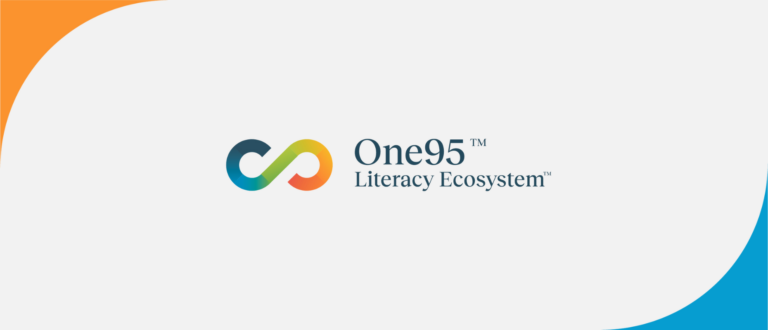
The science of reading: then and now

Delivering on the promise of education starts with the mastery of the most fundamental foundational skill—the ability to read. Not only is reading critical to the success of further education but it is an expected accomplishment in order to thrive in contemporary society.
Laura Stewart
We already know that the ultimate goal of reading with a depth and breadth of comprehension and fluency is a key to developing the critical thinking skills of children. According to the National Center for Educational Statistics (NCES), approximately 43 million (1 in 5) adults in the US have low to exceptionally low literacy skills. There is nothing more urgent than ensuring that all children have access to the instruction that will unlock their potential as readers, writers and thinkers.
The Reading League has stated that although the scientific evidence base for effective reading has existed for decades, the term “the science of reading” has gained traction in the last few years, potentially leading to misunderstandings. The Science of Reading: Defining Guide provides a firm definition of what the science of reading is, what it is not, and how all stakeholders can understand its potential to transform reading instruction: “the science of reading is a vast, interdisciplinary body of scientifically-based research about reading and issues related to reading and writing.”
For more information about this definition and why knowledge of best practices for reading instruction is so critical, check out our science of reading resource page and our brand new ebook aimed at bringing science of reading theory into practice: The Science of Reading 2.0: Implementation made easy.
What is a literacy ecosystem and why does it matter?
With any ecosystem approach, we have to sit squarely in some key foundational principles…the purpose in our work is to unlock that power of literacy for every child.
Laura Stewart
An ecosystem, as defined by the Oxford Dictionary, is “a complex network or interconnected system.” Systems, in general, are built with seamless interactions or integrations in order to optimize the process that’s being systematized.
This definition holds true in the case of a literacy ecosystem. In order to provide the most comprehensive acceleration of skills, the different parts of a literacy ecosystem have to work together and provide a foundation for a common knowledge, language and instructional routines.
Engaging, explicit, and evidence-based, the One95™ Literacy Ecosystem™ is a cohesive suite of resources that aligns to our mission and our standards of excellence; it equips educators with a comprehensive toolkit to unlock the power of literacy for every child. It integrates professional learning and evidence-based literacy products into one cohesive system that supports consistent instructional routines across tiers — so you’re ready and able to help every child realize their reading potential.
So what are the key ingredients of our One 95 Literacy Ecosystem and what sets it apart? In the next few sections we will explore why One 95 is the comprehensive toolkit your teachers and students need.
Our Literacy Ecosystem offers consistency. Students get into the instructional routines and teachers learn the instructional language; the beauty of these routines is that they are the same across all of the products in core and intervention.
Laura Stewart
There are four key ingredients to reading success with the 95 Percent Group: alignment, consistency, acceleration, and evidence.
We provide alignment and consistency across our ecosystem of evidence-based core and intervention offerings that lead to accelerated literacy improvement for every child. Let’s dig into each one of these to see how each component is key to the overall success of the ecosystem.
Alignment: Our instructional approach and content are aligned to the science of reading across each tier, with additional time, intensity, and focus provided in tiers 2 and 3. Alignment to the science of reading is based in understanding the body of evidence, and the nature of each new skill building upon and interacting with a previously learned skill.
Consistency: We help educators master a consistent approach to instruction across tiers and students which, in turn, helps them focus on what matters most—teaching. Likewise, students learn within consistent instructional routines across products, which helps them concentrate on what matters most—learning. This consistency in use of product as well as a common and consistent language allows teachers to be better equipped to support all students and offers students more confidence and agency in their learning.
Evidence: All resources are evidence-based within the science of reading research. We have high-quality efficacy studies that show our instruction works.
Acceleration: Our literacy ecosystem of evidence-aligned materials and methodology accelerates student progress, supporting each child in realizing their full potential and progressing to grade level.
On their own, each of these components may provide some value to a teacher’s literacy instruction. Together, they ensure that all students are receiving explicit, direct instruction in order to reach the ultimate goal of reading at or above grade level.
Tiers of literacy instruction: meeting all student needs with a common language and routines across levels and products
The different tiers of instruction represent who is receiving the instruction, and the time and intensity dedicated to the instruction. In general, all students participate in Tier 1, or core instruction. Students who have a need for more focused support according to informal or diagnostic assessment data participate in Tier 2 and Tier 3 instruction.
The One95 Literacy Ecosystem represents an acceleration model instead of a remediation model, because students who need more support are not pulled from core instruction to receive it. They receive intervention instruction in addition to their whole class core literacy instruction–and the intervention materials and instruction is directly connected to the work they are doing in their core instruction.
Let’s take a closer look.
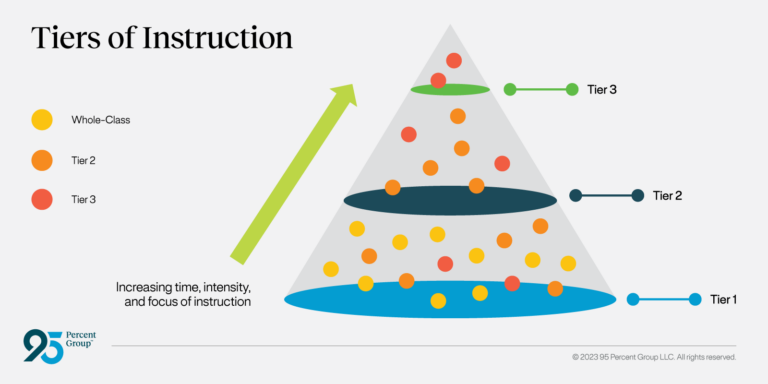
Tier I
Tier I instruction refers to the literacy instruction that the teacher is doing with the whole class. This is your core literacy instruction that all students receive. The hallmark of an effective Tier 1 program is a structured sequence that is delivered through explicit and direct instruction and offers student feedback and a scaffolded gradual release approach (I do, we do, you do).
Tier 2:
Tier 2 instruction is intervention for students who score below the grade level benchmark and need increased time, intensity (smaller group size) and focus (targeted skills identified by diagnostic screeners) of instruction. Tier 2 is also evidence-aligned enrichment and supports for students already at benchmark. It can provide enrichment for Tier 1 instruction.
Tier 3:
Tier 3 intensive intervention instruction is evidence-aligned and supports students not responding to Tier 2 instruction. It is highly individualized to already identified student needs. Our Tier 3 intervention instruction is based on our newly acquired product, 95 RAP™— a teacher-led, small group, digital solution for struggling readers, including those with dyslexia.
Additionally Tier 3 instruction can offer extension and support for students well-above benchmark.
Check out the on-demand webinar for more information!
*It’s important to note that for all three tiers of instruction, the scope and sequence of skills is the same; it is the intensity of instruction that differs.
Building an instructional ecosystem at your school
Knowledge of the body of evidence we call the science of reading is important, but understanding how to bring practical application of that knowledge into classrooms is critical for a successful implementation. Curriculum materials that are evidence-aligned and consistent across all tiers of instruction as well as professional learning to support teachers in implementation are key ingredients to building your instructional ecosystem with fidelity and accountability.
It [95 Percent Group] gives us one language around routines and best practices, and the ability to share information on students to make our Walk to Intervention model run smoothly. We have 120 kids shared by four classroom and intervention teachers. When we can easily share information and pinpoint skill gaps, this means everyone is supporting the learning of these students—it’s not just on one classroom teacher to make sure the students get what they need to reach their full potential.
Shari Kirkpatrick
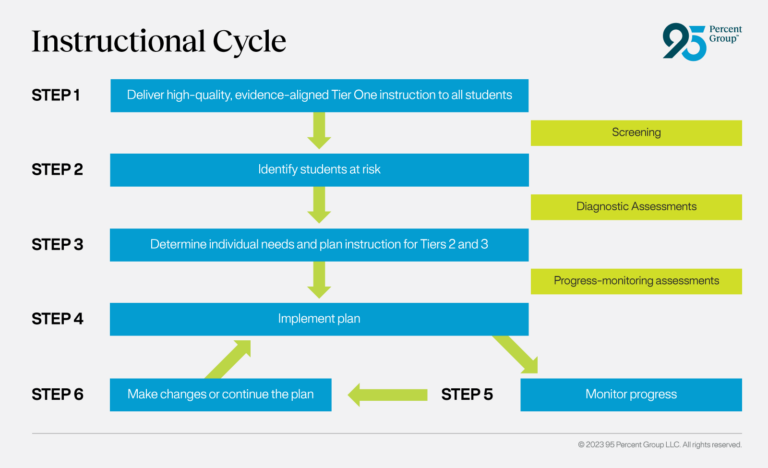
Implementing a universal literacy screener is helpful–but what is the best way for educators to use all of the data they are collecting? One way teachers can use the data they collect is to better understand their students’ needs: who is making or maintaining progress towards grade level reading with just Tier 1 instruction? Who needs more focused Tier 2 intervention or enrichment, and which students need the most intensive Tier 3 intervention?
95 Percent Group’s targeted diagnostic assessments map directly to the skills taught in materials across all Tiers of instruction, making it easy to implement as well as monitor student progress frequently in order to quickly inform critical instructional decisions.
One advantage of employing an instructional ecosystem, is that students and teachers encounter the same instructional routines whether they are working in Tier 1, 2 or 3 instruction–creating a seamless transition from Tier 1—whole class instruction, to Tier 2 or 3—intervention instruction. The absence of having to keep track of different instructional routines and languages means teachers and students have the cognitive space necessary for teaching and learning skills.
Although the One 95 Literacy Ecosystem is a one-stop shop for schools that want a core curriculum with intervention and enrichment instruction options, many schools decide to use certain products in tandem with other solutions they are employing concurrently. Our materials work nicely as an addition to other resources, or as a stand-alone option for all of your literacy needs.
One 95 Literacy Ecosystem successes from the field
It’s time for acceleration. It’s time to use the best resources available. Every child deserves to reap the benefits of a literate life. Every child, regardless of where they live, their background, their life experiences, deserves a place at the table. The minute the light bulb goes on for a child and when they realize they are reading…that is so magical!
Laura Stewart
Voices from Val Verde Unified School District
- “At the end that year, none of our students ended up qualifying to go into Tier 3 intervention because we were able to provide the data to show that the interventions we were doing with the PSI™ (Phonics Screener for Intervention™) and 95 Phonics Chip Kits were helping them to achieve their goals,” said Shari Kirkpatrick, early literacy instructional support team
Evidence of success: Panther Valley, PA
- 1st grade: 20% of 1st graders assessed in October were decoding on grade level according to the skills assessed in the PSI. This number soared to 70% on grade level in March. This is a 250% increase in students reading on grade level after 5 months.
Accelerate your students’ reading improvement
95 Percent Group is on a mission, and it’s an important one. Children today are at risk of falling behind if they don’t learn to read proficiently by the end of third grade. Our goal is to help all children flourish as literate citizens of the 21st century.
The One95 Literacy Ecosystem integrates professional learning and evidence-based literacy products into one cohesive system that supports consistent instructional routines across tiers — so you’re ready and able to help every child realize their reading potential.
Are you interested in learning about how you can bring the One 95 Literacy Ecosystem, grounded in the science of reading, to your school or district? Contact us today.

